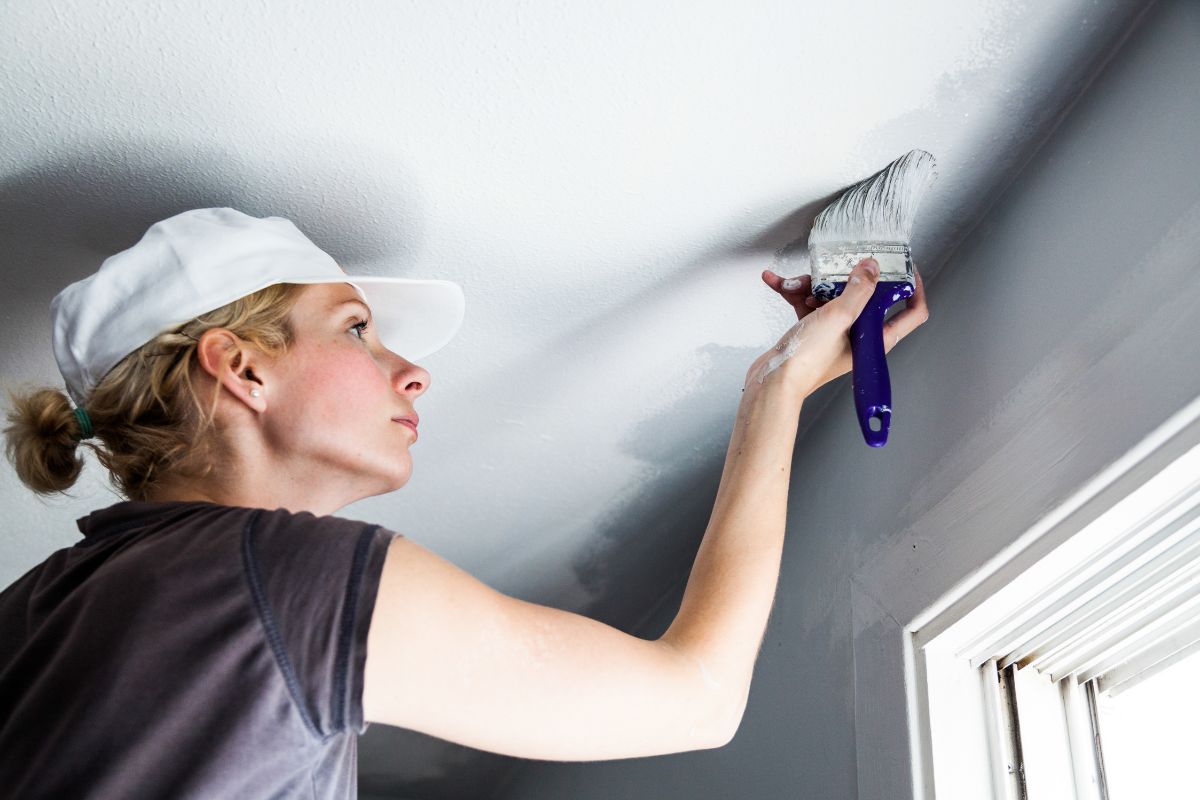Randy Charles is the owner of PaintCentric.com, a website dedicated to providing information, tips, tricks, and news about all things paint. With over 10 years...Read more
Prepare the Ceilings
To prepare your ceilings for painting, follow these steps, including three sub-sections. Start by cleaning the top, making necessary repairs, and covering the floor and furniture. These steps will ensure that your ceiling painting project goes smoothly without any hiccups along the way.
Clean the Ceiling
Prepare ceilings for painting or repair work with a thorough cleaning! Removing dirt, dust, and grime is critical to a smooth, long-lasting finish. Here’s a 6-step guide:
- Safety first! Wear goggles and masks.
- Soft-bristled brush or vacuum up surface dust.
- Mild detergent+warm water for stubborn stains/spots.
- Rinse off the solution with clean water.
- Dry with a clean towel or let air dry.
- Inspect for cracks or damages.
Identify the ceiling material before cleaning. Specialized cleaning may be needed for specific materials. A fact: warm water and mild dish soap can remove the stubborn stains from a painted ceiling without damaging it. Get ready for repairs – your roof shouldn’t be shedding more than your cat!
Make Necessary Repairs
Before painting a room, it’s necessary to repair and prepare the surfaces. Fixing any damage in the ceiling is critical for a smooth finish. Here are five steps to improve your roof:
- Find cracks, dents, holes, or water stains.
- Clean the area and remove any loose debris.
- Fill the damaged areas with spackling compound or drywall joint compound.
- Sand the spots until they are even.
- Prime and paint your ceiling.
Be careful when handling tools and materials. Cover light fixtures and vents with painter’s tape. Ancient Romans decorated ceilings with colorful mosaics. Protect your things from paint and dust. Cover them up!
Cover the Floor and Furniture
To protect furnishings and flooring, shielding them is vital! Follow these steps:
- Lay heavy-duty canvas or drop cloths on the floor to keep it scratch-free and prevent paint/plaster drips.
- Fill gaps between baseboards and floors, as paint spatters can quickly happen.
- Cover large furniture pieces with a suitable cover or plastic sheeting as they can’t be moved easily.
Painter’s tape is helpful when connecting fabrics. Also, roll up smaller rugs to avoid damage when working.
Preparing correctly is crucial, as even tiny paint drops can cause furniture and floor finish losses. Shield your furnishings and floors before starting any work.
Home Advisor reports that painting ceilings cost an average of $452. Avoid essential tools and go for the Rolls-Royce of ceiling preparation tools!
Select the Right Equipment
You need to start with the right tools to select the right equipment for painting a ceiling. The right choice of paint and finish will help you achieve a clean finish. Next, you need to pick a suitable brush that works well with the height and texture of the ceiling. Lastly, decide if you need a ladder before selecting the equipment.
Choose Paint and Finish

When picking the perfect paint and finish for your project, there are a few key points to bear in mind.
- Choose a paint that matches the surface you’re painting. Different characters need various types of paint.
- Opt for a finish that suits the look and function of the painted surface. A glossy finish will be more reflective, and a matte finish will be more subtle. If sturdiness is essential, go for a high-quality finish.
- Take into account where the painted surface will be positioned. Will it experience wind or moisture? If so, you might require a paint or finish specifically formulated for outdoor use.
- Think about any personal preferences you have for color or texture. Many options are available for these paint and finish features, so consider them before deciding.
- Remember, some paints and finishes may require special techniques or equipment. Read all the instructions thoroughly before starting your project.
- Safety is also critical when working with paint and finishes. Ensure proper air circulation in your workspace and wear protective gear like gloves and masks when needed.
In conclusion, by considering all these factors when selecting your paint and finish, you can ensure your finished product looks great and lasts for years. Choose your brush wisely – it’s all about compatibility and good chemistry.
Pick a Suitable Brush
Choosing the Ideal Brush
Figuring out the proper brush for your task is crucial to get the desired result. Here are some tips to help you find the best meeting for the job:
- Consider the surface you’ll paint on, and choose bristles that suit it.
- Estimate the area size to cover, and pick a brush with a wide width for quick coverage.
- Find the correct type of bristle for your paint. For instance, natural brushes are great for oil-based paint, while synthetic brushes are great for latex paint.
- Pick a shape that’s best for your project. Filbert, flat, angular, and round are all popular shapes.
Remember, too, that brushes have different stiffness levels for various techniques.
Fun Fact: An article from The Spruce Crafts says cleaning paintbrushes right after use is essential to make them last.
Decide if you need a ladder.
When assessing equipment for a task, consider if a ladder is needed. Here are four points to help:
- Think about the height of the task. Ladders may be necessary if it’s more than six feet high.
- Examine the stability needed. Ladders may give more secure footing for specific tasks.
- Check if obstacles prevent close access. A ladder may be needed for safe access.
- Look at other equipment that could work better. A scaffold or hydraulic lift may be better than a ladder.
Remember, each situation is different when it comes to ladders. Knowing safety protocols ensures safer practices and lessens accident risks.
Realizing ladders aren’t the only option is essential. Being knowledgeable about alternatives boosts efficiency and safety.
Recently, someone used stacked boxes instead of a ladder at home. The boxes collapsed and caused severe injuries. Evaluating alternatives first would have avoided this. Paint the ceiling instead of paying for therapy – unleash your frustrations for free!
Paint the Ceiling
To paint the ceiling properly and save yourself from the trouble of a streaky or uneven finish, follow the steps outlined in this article section. Cut in around the edges, roll the paint in small areas, and apply a second coat if necessary are the sub-sections that will be discussed.
Cut In Around the Edges
For crisp edge lines while painting, ‘cutting in’ is a must. This technique involves using a brush along the edges before rolling the area with a roller. Pro painters see it as a critical step for a professional finish.
Here’s a 4-step guide to edging like a pro:
- Put enough paint on the brush. Wipe off the extra from both sides.
- Hold the brush perpendicular to the edge and apply gentle pressure. Cut in a 2-inch broad line with steady strokes.
- Reload with paint if you need to change directions.
- Let the paint dry before a second coat.
Take your time, and be neat and precise. Beautiful results take time.
Also, special braces can help if you can’t keep your hand steady.
A story to learn from an apprentice who tasked his mentor to cut tight corners in an empty building without power. He turned on his phone flashlight to help but dropped it on wet paint, making a mess. After starting again with the mentor’s experienced advice, he learned that haste makes waste! Break the ceiling into sections instead of tackling it all at once.
Roll on the Paint In Small Sections
To get a smooth paint job on the ceiling, divide it into sections. This will give better coverage than more significant areas. Here’s how:
- Clean the top with a broom or vacuum.
- Cut in around the edges with a brush.
- Roll paint horizontally across the section from one corner to the other.
- Overlap areas slightly and blend them.
- Keep the coverage consistent.
Be careful not to apply too much pressure on the roller. And make sure there’s enough light to work in. Pro Tip: Use extension poles for your rollers to avoid neck or back strain. So, ceiling, lookin’ for a second coat?
Apply a Second Coat if Necessary

When painting the ceiling, a second coat may be essential. To get a smooth and even finish, do these four steps:
- Check for missed spots on the first coat.
- Sand down rough or uneven areas and clean them.
- Mix the paint well to avoid color and texture inconsistencies.
- Apply the second coat lightly and evenly, and let it dry properly.
The need for a second coat varies. Factors like paint color, wall color, and desired finish all play a role. Obtaining an even finish should be your priority when deciding whether to redo it.
Wear protective clothing like gloves and goggles, and make sure the area is adequately ventilated. Consider investing in good brushes or rollers, too.
In Egyptian tombs, ceilings were painted with detailed designs. Not only were they visually pleasing, but they also symbolized the deceased’s journey to the afterlife.
Painting a ceiling is challenging, but you don’t need weights—just gallons of paint!
Tips for Painting Ceilings

You must follow specific tips to ensure a flawless paint job on your ceiling. To achieve the desired results, this section, “Tips for Painting Ceilings,” with the sub-sections “Use Natural Light, Working from the Middle Outwards, Choose the Right Direction to Paint the Ceiling” as solutions, will help you to complete the task smoothly.
Also Read: How to Paint a Ceiling Without Getting Paint on Walls?
Use Natural Light
Natural sunlight can be a great way to paint ceilings. The light spreads across the room, giving better visibility and letting you check if the color is right. Stand where you don’t get glare from the window or skylight.
To avoid shadows, put a light underneath you. Don’t use artificial light at night, as it gives an uneven light, making it hard to judge the color.
Natural light gives the ceiling texture and depth, like popcorn and stipple finishes, which look better. And when the sun sets, if you’re not done, pause and wait until morning. This will help you avoid mistakes with the color combination and have a uniform look.
Painting a ceiling is like making friends: start in the middle and work your way out. And don’t forget to wear protective gear!
Work from the Middle Outwards
Start painting the ceiling from the center for an even finish. This will make sure the paint is spread out without streaks or drips. Manage the paint on the roller by going from the middle outward.
Work in one direction, and don’t move back and forth. This will help control how much paint goes on and reduce brush strokes. Keep a wet edge when using water-based paints.
Go slow and careful when cutting in at the wall’s edge. Get a high-quality angled brush for a professional look. Extend your roller with an extension pole to avoid neck strain.
Low-quality rollers and brushes can lead to shedding or fibers stuck on the surface. Buy Purdy Brushes and Wooster Rollers for a smooth finish. Don’t mix directions – it’s not a good look.
Choose the Right Direction to Paint the Ceiling.
Picking a direction for painting your ceiling can be a make-or-break factor in the result. Here are some tips to help you make the best choice!
- Work out whether to paint along the length or width of the ceiling.
- If your ceiling is high, paint it across the primary light source for fewer shadows.
- Start near the windows if your room has natural light fixtures. This will let potential drips dry away from the windows.
- Keep brush strokes parallel for a neat look.
- Mind where you start/stop painting to avoid creating lap marks.
Be mindful of your chosen direction, which can make or break the job. Follow these tips, and you’ll have a smooth and even paint job.
Frequently Asked Questions
What are the steps for painting a ceiling?
There are typically six steps for painting a ceiling. First, gather all necessary supplies. Second, prep the room by covering furniture, floors, and walls. Third, fill any cracks or holes with spackle and sand until smooth. Fourth, prime the ceiling with a roller. Fifth, paint the top with a roller, working in small sections. Finally, allow the top to dry completely before adding a second coat.
In what direction should I paint my ceiling?
Painting your ceiling perpendicular to the light source in the room is typically the best direction to avoid visible brush strokes and achieve an even finish. When using a roller, start painting in the corner of the ceiling farthest from the entryway and work across the room in sections.
What type of paint should I use for the ceiling?
It is recommended to use a flat or matte finish paint for a ceiling to avoid any visible imperfections. Satin or eggshell finishes can reflect too much light and highlight flaws in the ceiling’s surface.
What tools do I need to paint a ceiling?
You will need a paint roller, extension pole, paint tray, spackle, sandpaper, and painter’s tape. Optional tools include a paint sprayer and a paint edger for clean edges.
How long does it take to paint a ceiling?
The time it takes to paint a ceiling can vary depending on the room size, height, and number of coats needed. Typically, it can take 4-6 hours to paint a medium-sized room with one coat of paint and additional time for prep and drying.
Can I paint my ceiling without primer?
While it is possible to paint a ceiling without primer, it is not recommended. A primer helps to seal the surface and create an even base for the paint to adhere to. Skipping primer can result in uneven paint coverage and a lower-quality finish.

Randy Charles is the owner of PaintCentric.com, a website dedicated to providing information, tips, tricks, and news about all things paint. With over 10 years of experience in the painting industry, Randy has become an expert in the field and is passionate about helping others learn more about painting. He has written numerous articles on the subject and is committed to providing accurate and up-to-date information to his readers.
- Latest Posts by Randy Charles
-
How Much Do You Tip Painters? The Ultimate Guide
- -
Can You Paint Over Rust Converter?
- -
Can You Paint Inside When It Is Raining?
- All Posts
